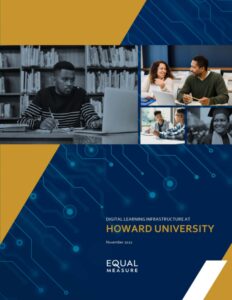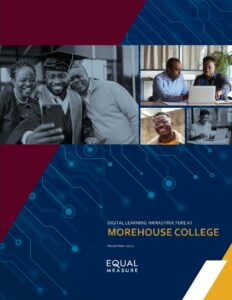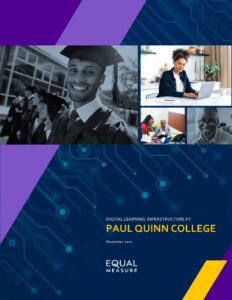by Victoria Worthen Lang, Senior Consultant, Equal Measure
Historically Black Colleges and Universities (HBCUs) increasingly seek to build and strengthen their digital learning infrastructure, to modernize the academic experience through virtual programs, meet demand for hybrid and online learning, and increase equitable access to their academic programming across the country. From 2021 to 2022, the Bill & Melinda Gates Foundation funded three HBCUs—Howard University, Morehouse College, and Paul Quinn College—to build on their digital learning infrastructure (DLI), advancing strategies to support the success of online students.
Through conversations with faculty, students, and administrators across these institutions, Equal Measure identified how five overarching components of the work can enhance DLI within each institution’s unique context. These five components include Leadership and Vision, Student-Centered Design, Staff and Faculty Development, Coordination and Partnership, and Centralized Operations and Supports.
While online programming is the focus of this post, digital learning is relevant to various learning modalities, including hybrid and in person, and refers to any experience involving technology, digital content, and instruction.
Leadership and Vision
Institutional leaders create a transformative vision for digital learning.
Institutions need visionary leaders, including presidents, provosts, deans, chiefs, faculty, and other staff, to work together on setting direction. Talent within the institution—the people with the knowledge, skills, and experience to shepherd DLI efforts—is a key factor in crafting a vision and strategy that is innovative but also feasible to achieve.
Howard University, Morehouse College, and Paul Quinn College are pursuing DLI activities according to a specific vision for digital learning. They have identified DLI as a strategic priority to remain not only viable, but as innovative institutions. Leaders view DLI as part of an institutional change process; it cannot be addressed in isolation to broader systemic and organizational systems. We learned from these HBCUs that every institution is unique in its history, culture, and capacity, and therefore each needs its own vision and strategy for implementing DLI. They integrated their vision and DLI priorities into documents that ground institutional activities, such as the institution’s strategic plan, providing momentum to develop and sustain DLI.
Student-Centered Design
When built around student needs for support, feedback, and belonging, DLI can improve student success.
The institutions recognized the importance of providing flexible support to online students who have competing priorities. Some examples include consistent, around-the-clock IT support, equitable access to digital resources and tools that on-campus students may find in their library, and setting up automated systems related to financial aid and enrollment where possible.
In addition, student-centered DLI ensures that students can provide feedback and be included in decision making to shape their educational experiences. Some examples of student-centered DLI include feedback loops, like town hall meetings, that allow for regular exchanges between students, faculty, and staff, and refinement of DLI based on student suggestions. Formal structures, like online student government bodies or advisories, provide space for students to advocate for their own needs in creating a high-quality online learning experience.
Finally, while DLI cannot replicate the experience of being on campus or connecting in person, some elements can be included in the DLI to create a culture of belonging for online students. These elements include communications tools and relationship-building technologies that allow for informal interaction between students and connection to the history, context, and culture of the institution. This may be a virtual space like the Howard Hallway, where students can “meet” and connect online, or messaging technologies like Morehouse College’s student-established GroupMe, where students can stay in contact and connect outside of class.
“So, if you were to ask me, ‘What’s the best possible outcome?’ It would be that students reap the most benefit from it, right? And that is what allows us to be a differentiator―is that we can genuinely, wholeheartedly, definitively say we’re building a better student experience for our population of students.” —Paul Quinn College faculty member
Staff and Faculty Development
Faculty proficiency with technology and early, consistent inclusion of faculty in program and course design can support a high-quality experience for students.
As the primary implementers of a DLI strategy, faculty require institutional support to develop content, use technology, and participate in decision making about DLI. Guidance on instructional design can help faculty translate in-person content into an engaging online course. Encouraging shared learning among faculty members and leveraging department champions to troubleshoot and develop skills promote a positive environment for DLI use. Comfort with technologies to administer the course and interact with students is essential to a seamless transition to online learning.
“Best practice moving forward needs to be in partnership with your faculty. … Find out where their gaps are and what their interests are … And then you make decisions. … You have to make sure that [faculty] are well-equipped, comfortable, and satisfied.” —Morehouse College faculty member
Coordination and Partnership
A successful partnership between an HBCU and external solution provider can boost digital learning capacity.
Online program managers (OPMs) and other solution partners are external organizations that provide technologies and support in areas such as course development, learning platforms, faculty training, and student advising. External partners were integral to bolstering the capacity of Howard University, Morehouse College, and Paul Quinn College in the early stages of their program and course development. OPMs can help standardize course content and ensure sufficient support for students and faculty. However, these partnerships work best when they are mutually beneficial for the solution providers and the institution. These benefits include reducing costs for the institution and other practices that avoid shifting financial risk to students and promoting long-term program sustainability.
“You have to keep your character and culture if you are dealing with an outside OPM. … We have to spend time with them on understanding that I am not trying to replicate the [predominantly white institution’s program]. This is the Howard program, and there are some things you need to know about Howard.” ―Howard University representative
Centralized Operations and Supports
Centralizing operations and supports creates efficiency and better programs.
Howard University, Morehouse College, and Paul Quinn College sought a seamless, user-friendly online learning experience for staff, faculty, and students. To enhance digital learning capacity, HBCUs need to upgrade services, platforms, IT infrastructure, and data architecture, including the hardware and software on campus. This upgrading may take the form of automating systems for enrollment or financial aid, providing consistent IT support, offering digitized content and resources, using consistent and interacting platforms (e.g., Blackboard, Zoom, Microsoft Teams), and integrating data. Ultimately, institutions seek to craft a “one-stop shop” or a single sign-on system, meaning that faculty and students only need to go to one place to easily access offices, technologies, and resources to be successful in their online learning experiences.
A strong DLI strategy is supported by these five components (Leadership and Vision, Student-Centered Design, Staff and Faculty, Coordination and Partnership and Centralized Operation and Supports), which promote a smooth experience for faculty, staff, and students. Developing and sustaining a DLI strategy that integrates these five components requires sufficient human and financial capital.
Lessons from the DLI experiences of Howard University, Morehouse College, and Paul Quinn College can be instrumental in helping other HBCUs develop and sustain successful DLI strategies. Funders seeking to better support HBCUs can look to these five components as they consider how to increase their impact on equitable student success.
DOWNLOAD THE PROFILES
| Howard University | Morehouse College | Paul Quinn College |
 |
 |
 |